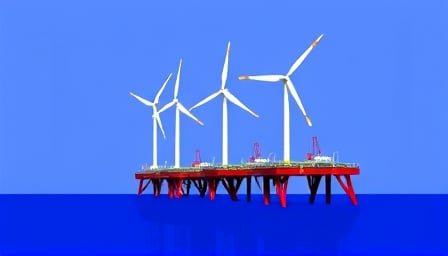Corporate News – In‑Depth Analysis
RWE AG’s Expanding Footprint in Renewable Power
RWE AG has achieved a pivotal milestone in its offshore wind portfolio with the completion of all 72 monopile foundations for the 1.1 GW Thor wind farm in the Danish North Sea. This project, positioned in a region renowned for robust wind resources, represents a significant capital outlay and logistical coordination. The successful installation underscores RWE’s technical capability and project management discipline, reinforcing its reputation as a dependable developer in the European offshore sector.
Joint Venture in France: The 1.5 GW Wind Farm
In parallel, RWE has secured a partnership with TotalEnergies to construct the largest clean‑energy wind farm in France, a 1.5‑GW installation. This joint venture signals a strategic alignment with a global energy conglomerate, pooling complementary strengths—RWE’s expertise in wind technology and TotalEnergies’ expansive network and financing capabilities. The French project will capitalize on the country’s strong renewable energy policy framework and the government’s aggressive decarbonisation targets, positioning both firms to capture a sizable share of the European market.
Investor Confidence Amid Political Uncertainty
Capital Group Companies’ purchase of a 3 % stake in RWE AG illustrates sustained investor confidence in the clean‑energy transition. The transaction is notable because it occurs against a backdrop of shifting political dynamics in the United States, where regulatory support for renewable projects has fluctuated. The investment signals that institutional investors are prioritising long‑term value creation associated with decarbonisation, rather than short‑term policy cycles.
Stock Performance Reflects Market Perception
RWE’s recent ascent to the top performer in the DAX index, with a 6.94 % gain over the past week, reflects market enthusiasm for its renewable initiatives. Stock price movements are often a proxy for investor sentiment regarding a company’s competitive positioning and growth prospects. The surge aligns with broader market trends favouring firms that demonstrate tangible progress in transitioning to low‑carbon operations.
Operational Challenges and Strategic Resilience
Despite these positives, RWE has encountered setbacks, notably its withdrawal from an agreement to purchase ammonia from the Hyphen Hydrogen Energy project in Lüderitz. Public opposition and protests exerted pressure that forced the company to reconsider its supply strategy. While the decision may be viewed as a short‑term loss, it also illustrates RWE’s willingness to adapt to stakeholder concerns and align its operations with evolving social expectations—a critical factor for long‑term sustainability.
Cross‑Sector Implications and Economic Context
RWE’s activities resonate beyond the renewable energy sector. The successful deployment of large offshore wind farms influences supply chains for steel, concrete, and specialised marine equipment, thereby stimulating ancillary industries. The partnership with TotalEnergies exemplifies how traditional oil and gas players are pivoting toward renewables, reflecting a broader shift in the global energy mix. Moreover, the capital inflows from asset managers like Capital Group enhance liquidity in the clean‑energy market, potentially lowering financing costs for future projects.
On a macroeconomic level, the growth of offshore wind capacity contributes to energy security, reduces dependence on fossil fuels, and aligns with European Union climate ambitions. The sector’s expansion is also expected to create skilled employment opportunities, fostering economic resilience in coastal regions.
Conclusion
RWE AG’s recent milestones—complete installation at Thor, the French joint venture, investor backing, and robust stock performance—demonstrate a firm that is advancing strategically within a rapidly evolving energy landscape. While challenges such as the ammonia supply dispute highlight the complexities of stakeholder engagement, RWE’s adaptive responses underscore its commitment to sustainable growth. Observers should watch how the company balances project execution, investor expectations, and regulatory pressures as the renewable energy sector continues to mature.
